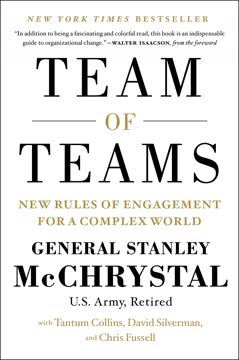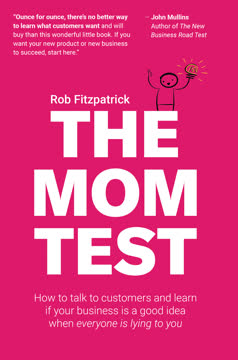Key Takeaways
1. Entrepreneurship is about nailing customer pain, not building products
"Any big problem is a big opportunity. No problem, no opportunity. … No one will pay you to solve a non-problem."
Find a monetizable pain. Successful entrepreneurs focus on identifying and solving significant customer problems, not just building cool products. Look for pains that are at least a 4 or 5 out of 5 in severity - problems so urgent that customers would take a cold call about potential solutions.
Validate the pain. Test your assumptions about customer pain early through cold calls, emails, and conversations. Aim for a 50%+ response rate as validation. Listen carefully to understand the root causes and impacts of the pain, not just surface-level symptoms.
Key steps:
- Write a clear monetizable pain statement
- Develop hypotheses about potential solutions
- Test pain and solution hypotheses with real customers
- Analyze feedback to refine your understanding
2. Test assumptions early and cheaply with rapid prototyping
"By limiting how long we work on something or how many people work on it, we limit our investment."
Prototype rapidly and cheaply. Create simple prototypes to test key assumptions about your solution before building a full product. This allows you to learn and iterate quickly without wasting resources.
Focus on the minimum viable product (MVP). Identify the core features needed to solve the customer's pain and test those first. Resist the temptation to add unnecessary bells and whistles. The goal is to validate your core value proposition as cheaply as possible.
Effective prototyping approaches:
- Paper sketches or mockups
- Simple landing pages
- Wizard of Oz prototypes (manual backend)
- Concierge MVP (manual service)
- Single-feature MVP
3. Seek intellectually honest learning through customer interactions
"I believe that too much money in a startup is not only unnecessary, it's actually toxic. It causes you to pursue losing strategies for too long to the detriment of the winning strategies."
Overcome learning traps. Be aware of cognitive biases like the confirmation bias, overconfidence, and motivation traps that can distort your interpretation of customer feedback. Actively seek out disconfirming evidence.
Develop an attitude of learning. Become an "expert novice" - maintain confidence in your knowledge while staying open to new information. Reframe your purpose from proving yourself right to discovering the truth about customer needs.
Keys to intellectually honest learning:
- Record and transcribe customer conversations
- Look for patterns across multiple data points
- Be willing to abandon or pivot ideas that aren't working
- Seek real-time feedback through rapid iteration
- Use data to drive decision-making, not just gut feel
4. Nail the solution before scaling the business
"Although you might dream of an ocean, you have to begin by understanding a puddle if you ever hope to make it to the ocean."
Iterate to product-market fit. Use a series of progressively more developed prototypes to refine your solution based on customer feedback. Start with virtual prototypes, move to working prototypes, then validate the full solution.
Focus on the minimum feature set. Identify the core features that drive customer purchase decisions. Ruthlessly eliminate nice-to-have features that don't directly solve the key pain points.
Three key tests:
- Virtual prototype test: Validate pain and initial solution ideas
- Working prototype test: Refine core features and user experience
- Solution validation: Confirm customers will pay for and adopt the product
5. Develop a go-to-market strategy based on customer buying processes
"The channel doesn't create demand, it fulfills demand."
Map the customer buying journey. Understand how customers become aware of solutions, evaluate options, and make purchase decisions. Use this to inform your marketing and sales approach.
Leverage the market infrastructure. Identify and engage key influencers, partners, and channels that shape customer perceptions and purchasing in your market.
Key elements to map:
- Customer awareness and information gathering processes
- Decision-making criteria and stakeholders
- Preferred channels and touchpoints
- Influencers and thought leaders in the space
- Potential partners and complementary solutions
6. Create a viable business model before pursuing rapid growth
"Goals are dreams with deadlines."
Validate key business model components. Use customer conversations to inform and test assumptions about revenue streams, cost structures, and key partnerships. Ensure you have a path to profitability before scaling.
Focus on unit economics. Understand your customer acquisition costs, lifetime value, and other key metrics. Ensure you can acquire customers profitably before aggressively pursuing growth.
Critical metrics to validate:
- Customer acquisition cost (CAC)
- Customer lifetime value (LTV)
- Gross margins
- Sales cycle length
- Churn rate
7. Scale operations, processes, and talent as the company grows
"Scale it until it breaks!"
Formalize and document key processes. As you grow, codify the tacit knowledge of founders and early employees into repeatable systems and processes. This enables you to onboard new team members effectively and maintain quality at scale.
Evolve the organizational structure. Recognize that the skills and structures needed in the early startup phase differ from those required to scale. Be willing to change roles, bring in experienced operators, and implement new management systems as you grow.
Key scaling activities:
- Document and transfer key processes
- Implement data-driven dashboards and metrics
- Evolve the team structure and roles
- Bring in experienced operators for key functions
- Maintain customer-centric culture as you grow
8. Adapt your approach based on market context
"There are 1000 things that can kill your company, you just need to get by them one at a time."
Tailor your strategy to market maturity. Recognize whether you're entering a new or established market and adapt your approach accordingly. New markets require more customer education and category creation, while established markets demand clear differentiation.
Consider ecosystem dynamics. In both new and established markets, be aware of complementary products, substitutes, and other ecosystem players that can impact your success.
Strategies for different contexts:
- New markets: Move deliberately, shape perceptions, create the category
- Established markets: Move fast, attack niches or low-end, leverage ecosystem
9. Use crises to force focus and drive necessary changes
"Most successful companies face a crisis before they succeed."
Embrace constraints. Limited resources can drive creativity and force ruthless prioritization. Use crises as catalysts to shed unnecessary features, refocus on core value propositions, and make hard choices.
Maintain a lean mindset. Even when resources are available, maintain the discipline and focus that comes from operating in crisis mode. Continuously question assumptions and be willing to make radical changes.
Crisis-driven focus tactics:
- Drastically cut burn rate to extend runway
- Shed non-core products or features
- Re-evaluate go-to-market strategies
- Double down on core value proposition
- Embrace creativity in resource allocation
Last updated:
FAQ
What's Nail It Then Scale It about?
- Entrepreneurship Focus: Nail It Then Scale It by Nathan Furr is a guide for entrepreneurs on creating and managing breakthrough innovations. It emphasizes validating customer needs before scaling a business.
- Five-Phase Process: The book outlines a structured five-phase process: Nailing the Customer Pain, Nail the Solution, Nail the Go-to-Market Strategy, Nail the Business Model, and Scale It.
- Real-World Insights: Authors Nathan Furr and Paul Ahlstrom provide practical advice and case studies from their extensive experience in the startup ecosystem.
Why should I read Nail It Then Scale It?
- Proven Methodology: The book presents a methodology that has helped numerous startups succeed by focusing on customer validation, saving entrepreneurs time and resources.
- Avoid Common Pitfalls: It addresses common mistakes, such as developing ideas without validation, helping readers navigate the entrepreneurial landscape more effectively.
- Expert Insights: Written by experienced entrepreneurs and investors, it offers valuable lessons from real-world experiences, making it a practical resource for starting or growing a business.
What are the key takeaways of Nail It Then Scale It?
- Customer-Centric Approach: Understanding and validating customer pain before developing a solution ensures the product addresses a real market need.
- Iterative Process: Emphasizes rapid experimentation and iteration, allowing entrepreneurs to test hypotheses and adapt based on customer feedback.
- Focus on Simplicity: Encourages simplifying offerings to the minimum feature set necessary, leading to faster development and greater customer satisfaction.
What is the NISI process in Nail It Then Scale It?
- Five Phases: The process includes Nailing the Customer Pain, Nail the Solution, Nail the Go-to-Market Strategy, Nail the Business Model, and Scale It.
- Customer Validation: Emphasizes customer validation at each stage, ensuring products meet real market needs and reducing the risk of failure.
- Iterative Learning: Encourages learning from experiences and adapting strategies based on customer feedback for continuous improvement and innovation.
How do I nail the customer pain according to Nail It Then Scale It?
- Write a Pain Statement: Articulate a Monetizable Pain Statement that clearly defines the customer pain you aim to address, focusing on urgency and significance.
- Engage with Customers: Conduct interviews and gather feedback from potential customers to validate the pain statement and ensure accurate understanding.
- Measure Response Rates: Use response rates from cold calls or emails as indicators of the pain's significance, suggesting whether the pain is monetizable.
What is a Monetizable Pain in Nail It Then Scale It?
- Definition: A Monetizable Pain is a significant customer problem that customers are willing to pay to solve, representing an urgent pain point.
- Importance: Identifying a Monetizable Pain is crucial for building a successful business, as it serves as the foundation for product development.
- Testing the Pain: Entrepreneurs should validate assumptions about customer pain through direct conversations and feedback to ensure they address a real market need.
What is the Big Idea Hypothesis in Nail It Then Scale It?
- Definition: The Big Idea Hypothesis is an entrepreneur's initial idea about the solution to the identified customer pain, serving as a starting point for development.
- Formulation: Entrepreneurs should articulate their Big Idea Hypothesis in a structured format, focusing on the target customer, the pain, and the proposed solution.
- Testing the Hypothesis: It should be tested through customer feedback and validation to ensure alignment with market needs, refining the idea before product development.
How do I conduct customer interviews effectively in Nail It Then Scale It?
- Prepare Key Questions: Develop focused questions to understand customer pain and gather feedback on your proposed solution, avoiding leading questions.
- Listen Actively: Prioritize listening over selling during interviews, creating an environment where customers feel comfortable sharing their thoughts.
- Record Insights: Take detailed notes or record conversations to capture valuable insights, helping identify common themes and inform product iterations.
What is the Minimum Feature Set (MFS) in Nail It Then Scale It?
- Definition: The Minimum Feature Set (MFS) is the smallest set of features necessary to drive a customer purchase, representing the core value proposition.
- Importance: Focusing on the MFS simplifies offerings, reducing development time and costs while increasing customer satisfaction.
- Iterative Development: Develop the MFS through rapid prototyping and customer feedback, allowing for adjustments based on real-world insights.
How can I create a successful go-to-market strategy according to Nail It Then Scale It?
- Market Infrastructure Mapping: Understand the market communication and distribution infrastructure, identifying key players, partners, and influencers.
- Pilot Customer Development: Engage with early customers to refine your product and validate go-to-market assumptions, using them as references for future sales.
- Continuous Feedback Loop: Maintain ongoing dialogue with customers to adapt your strategy as needed, staying aligned with market demands and expectations.
What are the crucial tests of hypotheses in the NISI process?
- Price Points: Test what customers are willing to pay through direct questions or gauging interest in pre-orders.
- Breakthrough Questions: Ask critical inquiries like whether customers would prepay for the product to assess market opportunity and commitment.
- Customer Feedback: Gather and analyze feedback to validate hypotheses, informing product development and marketing strategies.
What are the best quotes from Nail It Then Scale It and what do they mean?
- “The only valid market survey is a signed purchase order.”: Emphasizes the importance of actual customer commitment over mere interest, highlighting true validation.
- “Focus is the key to successfully running the NISI process.”: Stresses maintaining a clear focus on customer needs and core value proposition to avoid diluting efforts.
- “A crisis can create focus, commitment, and time.”: Reflects the idea that challenging situations can lead to transformative changes, strengthening a company’s direction.
Review Summary
Nail It then Scale It receives mostly positive reviews, with readers praising its practical advice for entrepreneurs. Many find the book's step-by-step approach to starting a business valuable, emphasizing customer feedback and problem-solving. Some readers appreciate its blend of lean startup principles and business model generation. However, a few critics note repetitive content and formatting issues. Overall, readers recommend it as a helpful guide for startups, particularly in tech industries, with its focus on reducing failure risks and validating ideas before scaling.
Similar Books










Download PDF
Download EPUB
.epub digital book format is ideal for reading ebooks on phones, tablets, and e-readers.






